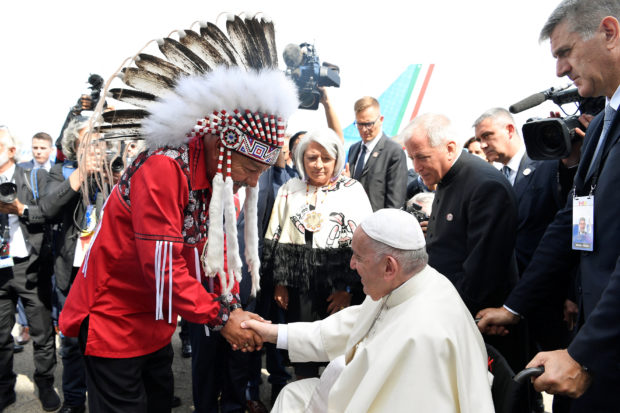
Pope Francis is welcomed after arriving at Edmonton International Airport, near Edmonton, Alberta, Canada July 24, 2022.(Vatican Media/Divisione Produzione Fotografica/Handout via REUTERS)
EDMONTON, Alberta – Pope Francis landed in Canada on Sunday to kick off a week-long trip that will center around his apology on behalf of the Roman Catholic Church for the abuse that indigenous children endured at mostly church-run residential schools.
“This is a trip of penance. Let’s say that is its spirit,” the pope told reporters after his flight took off from Rome.
The papal plane touched down in Edmonton in the western province of Alberta, where he will visit a former residential school and meet with indigenous peoples on Monday. He is also visiting Quebec City and Iqaluit, the capital of the territory of Nunavut. He will depart on Friday.
Between 1881 and 1996 more than 150,000 indigenous children were separated from their families and brought to residential schools. Many children were starved, beaten and sexually abused in a system that Canada’s Truth and Reconciliation Commission called “cultural genocide.”
The papal plane taxied with Canadian and Vatican flags flapping outside the cockpit windows. After disembarking with the help of a lift, the pope boarded a white Fiat 500X, which dropped him at the hangar. He then proceeded by wheelchair.
Governor General Mary Simon, who represents Canada’s head of state, Queen Elizabeth, was the first to greet the pope. Canadian Prime Minister Justin Trudeau followed.
The pope sat between the two Canadian officials for a short performance of four drummers and native singing before several indigenous leaders, many wearing elaborate headdresses, greeted and exchanged gifts with him.
“I asked today the pope to walk with us,” Grand Chief George Arcand of the Confederacy of Treaty Six First Nations said in an interview with the Canadian Broadcasting Corp. “It was a very humbling experience to talk to your holiness.”
RoseAnne Archibald, national chief for the Assembly of First Nations, who also greeted the pope, criticized the “unilateral” organization of the trip and the “archaic” nature of the church, which has no women in leadership positions.
“We don’t feel that it has been about survivors” of residential schools, she told reporters at the airport. “It has been more about the church promoting the church’s idea, fundraising for the church.”
The pope left after the short ceremony in a wheelchair to speak for a few minutes in private with Trudeau and other officials before heading to St. Joseph Seminary, where he is expected to rest before Monday’s events.
The 85-year-old pope canceled a trip to Democratic Republic of Congo and South Sudan in early July because of a knee problem that has recently forced him to use a wheelchair and a cane.
Earlier aboard the papal plane, the pope said he yearned to visit Ukraine in his efforts to try and bring an end to the five-month-old war that he has repeatedly decried.
“I have a great desire to go to Kyiv,” the pope said when asked about a possible future trip to Ukraine.
In an exclusive interview earlier this month, the pontiff told Reuters that he hoped to be able to go to Moscow and Kyiv soon after his trip to Canada.
While Canada’s leaders have known about high numbers of children dying at the residential schools since 1907, the issue was thrust to the fore with the discovery of suspected unmarked graves at or near former residential school sites last year.
In response to pressure stemming from those discoveries, the pope apologized for the Catholic church’s role in the schools earlier this year during a visit by indigenous delegates to the Vatican.
Now he is preparing to apologize on Canadian soil. But survivors and indigenous leaders have told Reuters they want more.
Many have called for financial compensation, the return of indigenous artifacts, the release of school records, support for extraditing an accused abuser, and the rescinding of a 15th-century doctrine justifying colonial dispossession of indigenous people in the form of a papal bull, or edict.